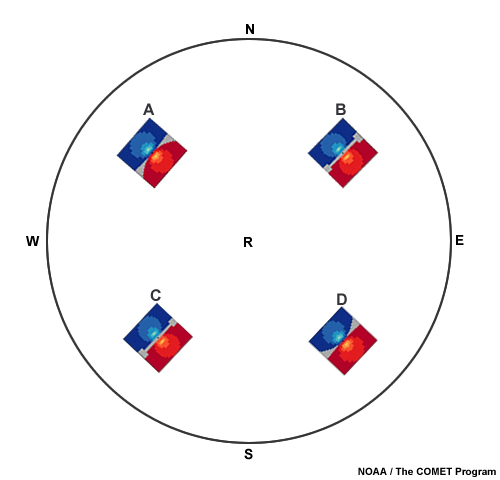Couplet A:
--
Clockwise rotation
Counterclockwise rotation
Divergence
Convergence
The correct answer is "Convergence". The radar beam will first encounter a small region of intense outbound velocities followed immediately by intense inbound velocities. This means that the winds must be blowing toward each other, or converging, in the middle of the couplet.
Please make a selection.
Couplet B:
--
Clockwise rotation
Counterclockwise rotation
Divergence
Convergence
The correct answer is "Counterclockwise rotation". There is a small region of intense outbound velocities to the right of a radial drawn through the center of the couplet and intense inbound ones immediately to the left. This means that winds must be blowing to the southwest on the right side of the radial and immediately turning around to blow to the northeast on the other side of the radial, making a counterclockwise circulation.
Please make a selection.
Couplet C:
--
Clockwise rotation
Counterclockwise rotation
Divergence
Convergence
The correct answer is "Clockwise rotation". There is a small region of intense inbound velocities to the right of a radial drawn through the center of the couplet and intense outbound ones immediately to the left. This means that winds must be blowing to the northeast on the right side of the radial and immediately turning around to blow to the southwest on the other side of the radial, making a clockwise circulation.
Please make a selection.
Couplet D:
--
Clockwise rotation
Counterclockwise rotation
Divergence
Convergence
The correct answer is "Divergence". A radar beam drawn through this location would first show a small region of intense inbound velocities followed immediately by intense outbound velocities. This means that the winds must be blowing away from each other, or diverging, in the middle of the couplet.
Please make a selection.
